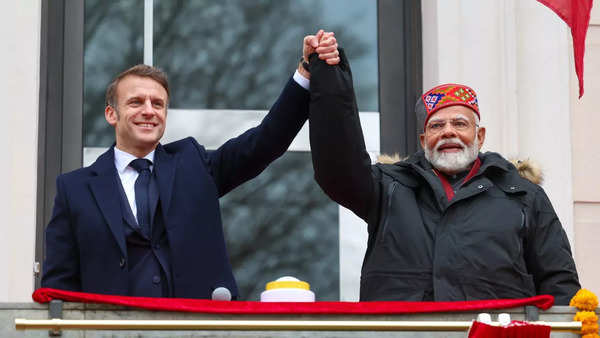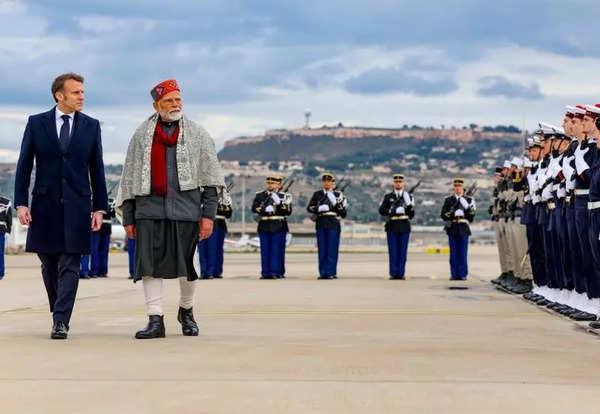Prime Minister Narendra Modi’s sartorial choices often capture attention, but one recent look, in particular, stood out when he wore the traditional ‘Kulluvi cap‘ during his visit to France. The ‘Kulluvi cap’, also known as the ‘Kulluvi topi’, is a quintessential part of Himachal Pradesh’s rich cultural heritage. By wearing it on the international stage, Modi not only showcased his personal affinity for the culture of Himachal but also brought this traditional headgear into the global spotlight. The image of him donning the cap alongside French President Emmanuel Macron, shared by Raj Bhawan on social media, sent a wave of pride across the people of Himachal Pradesh. The look was praised across political and non political lines, emphasizing how such a simple accessory can transcend politics and become a symbol of regional pride.
What makes the Kulluvicap special?
The Kulluvi cap is more than just a piece of clothing, it’s an expression of identity, history, and craftsmanship. This iconic cap, traditionally worn by the people of the Kullu Valley in Himachal Pradesh, is celebrated for its intricate design, vibrant colors, and cultural significance. Here’s why the Kulluvi cap is so much more than a mere accessory:
Handwoven craftsmanship
The Kulluvi cap is primarily handwoven using wool. Skilled artisans from the region carefully craft each cap, often incorporating bright, bold colours like green, red, and maroon. The weaving process involves intricate patterns that can take hours, if not days, to complete, making each cap unique. The craftsmanship is passed down through generations, preserving traditional methods that contribute to the region’s economic and cultural fabric.

Cultural heritage
The cap is closely associated with the diverse tribes and communities of Himachal Pradesh. It symbolizes not just the region’s art but also its history. In the past, the Kulluvi cap was worn by men during ceremonial events, festivals, and daily life. The colorful and symbolic designs represent various cultural beliefs and tell stories of the community’s past, embodying both pride and unity.
Symbol of regional pride
For the people of Himachal Pradesh, the Kulluvi cap is a point of immense pride. It connects them to their roots, a reminder of their heritage. The cap is often worn during celebrations, religious festivals, and traditional ceremonies. It has become a symbol of the state’s regional identity, much like how the Pahadi culture is unique to Himachal Pradesh.
Varieties of the Kulluvi cap
While the most popular version is the Kulluvi cap, the region is home to a variety of different caps, each with distinct characteristics. For example, the Kinnauri, Bushehri, and Kullvi caps are all variations that reflect the diverse artistic traditions and regional influences within Himachal. The Kinnauri cap is known for its velvety green texture, the Bushehri cap has maroon hues, while the Kullvi cap is often adorned with multi-colored straps, offering a bold and artistic flair. Each style represents different regions and subcultures within Himachal Pradesh, yet all maintain the central theme of rich craftsmanship and cultural pride.
Blend of tradition and modernity
What makes PM Modi’s decision to wear the Kulluvi cap even more significant is how he bridges tradition with modernity. While the cap has long been associated with rural life, local festivals, and regional leaders, wearing it on a global platform like his visit to France suggests a broader acceptance and celebration of regional cultural expressions. It’s a statement that traditional attire doesn’t belong to a particular era or place, it can be worn proudly by anyone, even in the most cosmopolitan settings.
PM’s look: A lesson in cultural appreciation
Prime Minister Modi’s choice to wear the Kulluvi cap during his diplomatic visit to France was a powerful gesture of cultural appreciation. Far from being a mere fashion statement, the cap became a symbol of Modi’s respect for the rich cultural diversity of India. By wearing it during an international summit, he not only represented Himachal Pradesh but also sent a message about the importance of preserving and celebrating local traditions in a modern world.
The act of wearing the Kulluvi cap was widely praised by people from all walks of life, including political leaders. The Leader of Opposition, Jai Ram Thakur, posted on social media, expressing his pride in seeing the Himachali cap being worn on such an important global stage. Even Congress leader Vikramaditya Singh, while offering his critique of Modi’s politics, lauded the gesture as something that every Himachali should feel proud of.

One X (formerly Twitter) user shared their thoughts, stating, “No one has represented Himachal like this before, as our PM does. While local leaders have made it a symbol only for rallies or special events, PM Modi wears it with pride, from local events to international summits.” This comment highlighted how Modi’s idea of wearing the cap wasn’t just about aesthetics, it was about making a statement. The Kulluvi cap is now associated with pride, cultural richness, and the idea of taking one’s heritage global.
PM Modi’s decision to wear it during his visit to France was not just a fashion statement, but a celebration of Himachal’s unique cultural identity. It bridged the gap between local traditions and global diplomacy, showing that cultural pride can be worn on the world stage with elegance and grace. Whether as a fashion statement or a symbol of pride, the Kulluvi cap is here to stay, continuing to inspire and represent the essence of Himachal Pradesh to the world.







